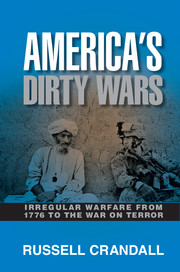Book contents
- Frontmatter
- Dedication
- Contents
- List of Figures
- Acknowledgments
- 1 Introduction
- 2 Irregular Warfare 101
- Part One The American Revolution to Chasing Sandino, 1776–1930s
- Part Two The Cold War, 1940s–1989
- 12 Cold War Counterinsurgencies
- 13 Intermezzo
- 14 Fighting Communism in Greece
- 15 Intermezzo
- 16 Intermezzo
- 17 Intermezzo
- 18 Ramón Magsaysay and the Hukbalahap Rebellionin the Philippines, 1946–1956
- 19 Vietnam
- Part Three Latin America and the Cold War, 1950s–1980s
- Part Four Post–Cold War, 1990s–2000s
- Notes
- Bibliography
- Index
18 - Ramón Magsaysay and the Hukbalahap Rebellionin the Philippines, 1946–1956
Published online by Cambridge University Press: 05 July 2014
- Frontmatter
- Dedication
- Contents
- List of Figures
- Acknowledgments
- 1 Introduction
- 2 Irregular Warfare 101
- Part One The American Revolution to Chasing Sandino, 1776–1930s
- Part Two The Cold War, 1940s–1989
- 12 Cold War Counterinsurgencies
- 13 Intermezzo
- 14 Fighting Communism in Greece
- 15 Intermezzo
- 16 Intermezzo
- 17 Intermezzo
- 18 Ramón Magsaysay and the Hukbalahap Rebellionin the Philippines, 1946–1956
- 19 Vietnam
- Part Three Latin America and the Cold War, 1950s–1980s
- Part Four Post–Cold War, 1990s–2000s
- Notes
- Bibliography
- Index
Summary
[We] can only hold out as long as it is supported by the masses. No more, no less.
– Luis Taruc, leader of the communist insurgency in the Philippines, 1948After the victory over Aguinaldo’s guerrillas in the Philippines in 1902, the United States governed the archipelago for the next half-century. Japan’s occupation of the Philippines during World War II led to the ignominious surrender of 15,000 American troops at Bataan and forced American general Douglas MacArthur to evacuate his forces to Australia. While the United States regrouped and prepared to win back the Pacific, over 250,000 Filipinos participated in some form of guerrilla activity against the Japanese occupiers during the course of the war as part of the People’s Anti-Japanese Army, the Hukbalahap.
While their name suggests that they were singularly focused on fighting the Japanese, the Huks did not lay down their arms following independence. Rechristening themselves the People’s Liberation Army, they returned to guerrilla warfare, this time to overthrow what they considered a corrupt and illegitimate government in Manila. While much of the Huk leadership came from the educated urban class, the Huk cause was bolstered by the miserable labor and land conditions in much of rural Luzon; malnourishment was rife and few campesinos owned their own land. After fighting the Japanese, many in the Philippines felt that they deserved a greater voice in political affairs as well as control of their land. Even General MacArthur admitted the Huks’ appeal in the countryside: “If I worked in those sugar fields, I’d probably be a Huk myself.”
- Type
- Chapter
- Information
- America's Dirty WarsIrregular Warfare from 1776 to the War on Terror, pp. 199 - 208Publisher: Cambridge University PressPrint publication year: 2014



